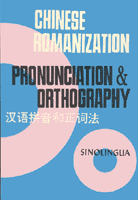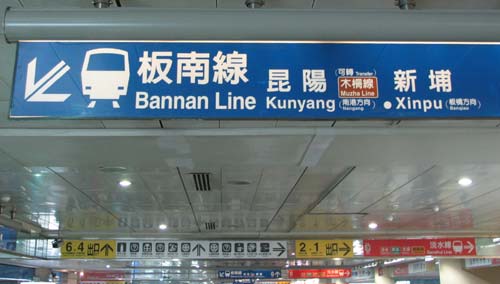I haven’t posted anything in Pinyin lately. So here’s a story from a couple of days ago, giving some of the history of Taipei’s stupid and now disavowed “nicknumbering” system, under which the city’s main roads were given numbers for the supposed convenience of foreigners. But since no locals knew these numbers, the nicknumbering system helped basically no one find anything — something the city should have figured out before it wasted all that money putting up signs. The real problem was that the romanization on the city’s signs was FUBAR — something that was finally addressed a little later.
Táiběi shìyìyuán Lǐ Xīn zhǐchū, Táiběi shìzhèngfǔ zài Mínguó 89 nián [2000 — I’ve changed the rest of the dates to international years] tuīchū de “dàjiē dàdào” (lùpái jiāzhù Yīngwén xùhào) zhèngcè, jìngrán zài 7 yuè jīng shìzhǎng Hǎo Lóngbīn tóngyì, juédìng “bù wán le”. Tā tòng pī shì-fǔ zhèngcè fǎnfù, bànlǐ dānwèi Mínzhèngjú zéwúpángdài, yīng gěi shìmín yī ge jiāodài.
Mínzhèngjú biǎoshì, zǎo zài 2002 nián tǒngyī shǐyòng Hànyǔ Pīnyīn qián, yǐ tuīdòng “dàjiē dàdào” zhèngcè, gù bùfen biāoshì pái cǎi Tōngyòng Pīnyīn, liǎngzhě luóji bìngbù yīzhì; cǐwài, yuèláiyuè duō wàijí guānguāngkè juéde lái Táiwān jiùshì yào tǐhuì “Zhōng-xiào, Rén’ài, Xìnyì, Hépíng” de Rújiā jīngshén shì mìngmíngfǎ, shùzì xíng jiēdào míng fǎn’ér xiǎnde méiyǒu tèsè.
Mínzhèngjú juédìng cóngshànrúliú, gǎi yǐ Hànyǔ Pīnyīn zuòwéi tǒngyī yìyīn, bùzài zhíxíng “dàjiē dàdào” zhèngcè.
Lǐ Xīn biǎoshì, shì-fǔ yǐ “fāzhǎn guānguāng, xiézhù wàijí rénshì biànrèn” wéi yóu, 2000 nián qǐ dàzhāngqígǔ, jiāng shìnèi 10 tiáo dōng-xī xiàng zhǔyào dàolù dìng míngwéi “dì-yī zhì dì-shí dàdào”; 14 tiáo nán-běi xiàng zhǔyào dàolù dìng míngwéi “dì-yī zhì dì-shísì dàjiē”.
Bùjǐn zài zhèxiē lùduàn de lùpái, shì-fǔ xuānchuánpǐn dōu xīnzēng xiāngguān Yīngwén biāoshì, yě yāoqiú yuánjǐng shújì, yǐbiàn zhǐyǐn wàijí guānguāngkè.
Bùliào shíguòjìngqiān, céngjīng bèi lièwéi qián Táiběi shìzhǎng Mǎ Yīngjiǔ zhòngyào zhèngjì de dàjiē dàdào zhèngcè, yīn shíshī guòchéng hùnluàn, xiàoguǒ bùjiā, yǐ yóu Hǎo Lóngbīn qiānzì juédìng “shōubīng” bùzài shīxíng, wèilái jiāng zhúbù yǐ Hànyǔ Pīnyīn tǒngyī yìyīn.
Mínzhèngjú biǎoshì, 1998 nián guānguāng wěiyuánhuì wěiyuán kāihuì shí, dāngshí yà dōu lí zhì zǒngcái Yán Chángshòu tíchū fǎngxiào guówài dàjiē dàdào mìngmíng fāngshì, huòkě tíshēng lái Táiwān guānguāng de wàijí lǚkè, zài Táiběi jiào yì biànshí fāngwèi; shì-fǔ jīngguò duōfāng pínggū, 2000 nián zhèngshì tuīdòng dàjiē dàdào zhèngcè.
Bùguò zài lùpái jiāzhù Yīngwénbǎn dàjiē dàdào míng hòu, duì wàijí lǚkè bāngzhù bùdà, bùshǎo běndì mínzhòng bèi wèndào “dì-yī dàdào zài nǎli?” fǎn’ér yī tóu wùshuǐ, gēnběn huídá bù chūlai. Yīncǐ jiēxiàlái shì-fǔ huì zhúnián biānliè yùsuàn, yǐ Hànyǔ Pīnyīn tǒngyī lùpái yìyīn.
Thanks, Dan, for alerting me to this.
source: Dàjiē dàdào bù wán le — yìyuán tòng pī (大街大道不玩了 議員痛批), United Daily News, October 27, 2008


 I’ve just put online another excerpt from Yin Binyong’s book about Pinyin. This one covers
I’ve just put online another excerpt from Yin Binyong’s book about Pinyin. This one covers 

